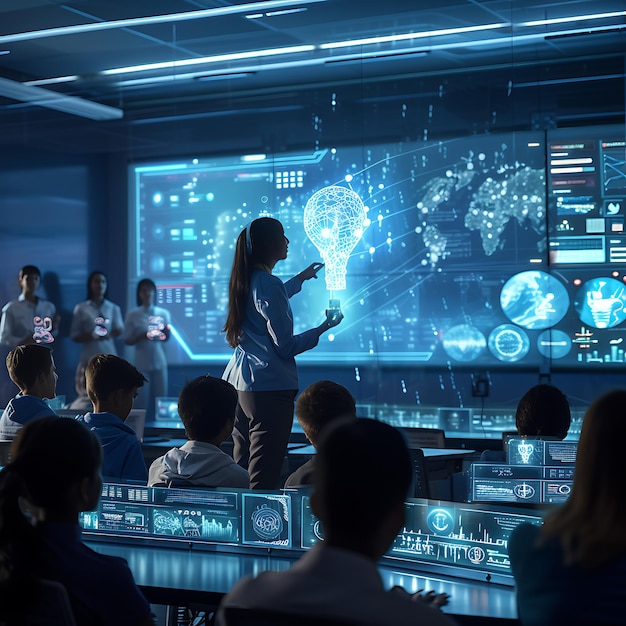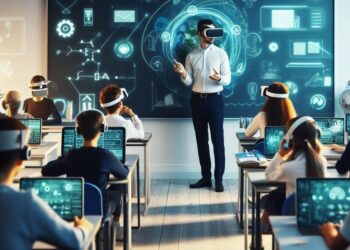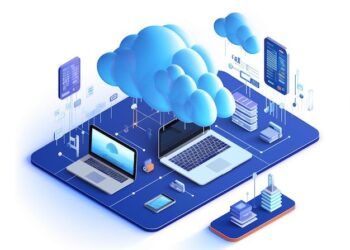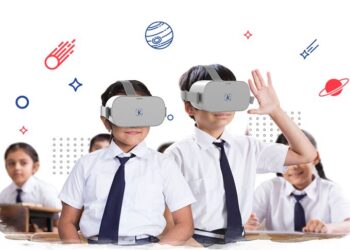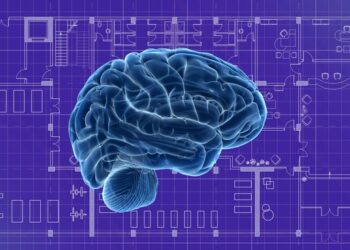The landscape of modern education is experiencing an unprecedented transformation as artificial intelligence technologies reshape how students learn, interact, and achieve academic success.
Recent data reveals that 26% of teens now use ChatGPT for schoolwork, doubling from 13% in 2023, indicating a significant shift toward AI-powered learning solutions.
This revolutionary change represents more than a technological upgrade—it signals a fundamental reimagining of educational possibilities.
The Digital Generation Leading Educational Change
Today’s students represent the first generation to naturally integrate artificial intelligence into their daily academic routines.
Six out of ten teachers report using AI tools for work during the 2024-2025 school year, demonstrating that both educators and learners are embracing this technological evolution simultaneously.
This mutual adoption creates a unique educational ecosystem where traditional teaching methods blend seamlessly with cutting-edge AI capabilities.
The transformation extends beyond simple tool usage. Students are developing new learning strategies, approaching problem-solving differently, and cultivating digital literacy skills that will serve them throughout their careers.
Understanding the advantages and challenges of artificial intelligence in education has become essential for making informed decisions, requiring both students and educators to adapt their approaches thoughtfully.
Personalized Learning Experiences Transform Academic Success
One of the most significant advantages students experience through AI integration involves personalized learning pathways. AI technology enables tailoring learning experiences to individual needs, enhancing academic performance while seamlessly catering to diverse learning requirements.
This customization extends to various learning styles, accommodating visual, auditory, kinesthetic, and reading-focused learners with unprecedented precision.
Students benefit from AI-powered platforms that adapt content difficulty based on their progress, provide instant feedback, and identify knowledge gaps requiring additional attention.
These systems analyze learning patterns, suggesting optimal study schedules and recommending resources that align with individual comprehension speeds and preferences.
The personalization extends to assessment methods as well. AI tools can generate practice questions tailored to specific weaknesses, create custom study guides based on learning history, and provide targeted remediation for challenging concepts.
This level of individualization was previously impossible in traditional classroom settings with limited teacher-to-student ratios.
Revolutionary AI Applications Reshaping Classroom Dynamics
Modern educational AI applications extend far beyond simple question-answering systems. Students now access sophisticated tutoring systems, collaborative writing assistants, and interactive learning companions that provide 24/7 academic support.
These tools complement traditional instruction rather than replacing human teachers, creating hybrid learning environments that maximize educational effectiveness.
A. Intelligent Tutoring Systems Provide Continuous Support
Advanced AI tutoring platforms offer personalized instruction across multiple subjects, adapting their teaching methods to match individual learning preferences.
Students receive immediate feedback, detailed explanations, and progressive skill-building exercises that adjust automatically based on performance data. These systems identify misconceptions early, preventing the accumulation of knowledge gaps that traditionally hindered academic progress.
B. Collaborative Writing Enhancement Tools Improve Communication
AI-powered writing assistants help students develop stronger communication skills by providing real-time grammar corrections, style suggestions, and clarity improvements.
Students learn to express ideas more effectively while receiving constructive feedback that enhances their writing abilities over time. These tools serve as patient mentors, offering unlimited practice opportunities without judgment or time constraints.
C. Interactive Language Learning Platforms Accelerate Fluency
Foreign language acquisition receives significant enhancement through AI-powered conversation partners, pronunciation analyzers, and cultural context providers.
Students practice speaking skills with patient AI tutors that correct pronunciation, explain grammar rules contextually, and provide immersive conversation experiences that build confidence and fluency naturally.
D. Advanced Mathematics Problem-Solving Assistants
Complex mathematical concepts become more accessible through AI tools that break down problems into manageable steps, provide multiple solution approaches, and visualize abstract concepts through interactive demonstrations.
Students develop deeper mathematical understanding by exploring various problem-solving strategies and receiving immediate verification of their work.
Overcoming Traditional Educational Barriers Through Innovation
AI disruption serves as a catalyst rather than a threat, potentially providing educators, students, and families the support needed to fulfill education’s promise as an equalizing force.
This transformation particularly benefits students who previously struggled with traditional learning methods or lacked access to quality educational resources.
Students with learning differences find AI tools especially valuable for accommodation and support. Text-to-speech capabilities, visual learning aids, and customizable interfaces create inclusive learning environments that adapt to diverse needs.
Similarly, students in under-resourced schools gain access to high-quality educational content and personalized tutoring previously available only in premium educational settings.
Breaking Geographic and Economic Educational Barriers
AI-powered educational platforms democratize access to world-class instruction regardless of geographic location or economic circumstances.
Students in rural areas access the same quality resources as their urban counterparts, while those from economically disadvantaged backgrounds receive tutoring support that levels the academic playing field. This accessibility represents a fundamental shift toward educational equity.
The technology also supports non-traditional learners, including adult learners returning to education, homeschooled students, and those with irregular schedules.
AI systems provide flexible learning opportunities that accommodate various life circumstances while maintaining educational rigor and progress tracking.

Developing Essential 21st Century Skills Through AI Integration
Students using AI tools develop crucial digital literacy skills that extend beyond academic applications. They learn to evaluate AI-generated content critically, understand algorithmic limitations, and develop ethical frameworks for responsible technology usage.
These skills prove essential for future career success in an increasingly AI-integrated professional landscape.
A. Critical Thinking Enhancement Through AI Interaction
Working with AI systems requires students to formulate clear questions, evaluate responses critically, and synthesize information from multiple sources.
This process strengthens analytical thinking skills as students learn to identify bias, assess credibility, and recognize when AI responses require human verification or additional research.
B. Creative Problem-Solving Skill Development
AI tools serve as creative partners, helping students brainstorm ideas, explore alternative approaches, and overcome creative blocks.
Students learn to leverage AI capabilities while maintaining their unique perspectives and creative voices, developing collaborative skills that will prove valuable in future workplace environments.
C. Digital Communication Proficiency Building
Interacting with AI systems teaches students to communicate clearly and precisely, formulating requests that generate desired outcomes.
These communication skills translate directly to professional environments where clear, specific instructions and feedback are essential for project success.
D. Ethical Technology Usage Understanding
Students develop frameworks for responsible AI usage, learning to avoid plagiarism, respect intellectual property, and maintain academic integrity while benefiting from AI assistance.
These ethical considerations prepare students for responsible technology usage throughout their careers.
Addressing Challenges and Concerns in AI-Enhanced Learning
While AI integration offers tremendous benefits, students and educators must navigate legitimate concerns regarding privacy, dependence, and academic integrity.
AI firms constantly seek data to improve their systems, raising privacy concerns for students using educational AI tools. Students must learn to balance AI assistance with independent thinking and original work creation.
Educational institutions implement policies that guide appropriate AI usage while maintaining academic standards. Students learn to use AI as a learning tool rather than a replacement for critical thinking, developing skills that complement rather than substitute for human intelligence.

Building Healthy AI Relationships for Long-term Success
Students benefit most when they view AI as a powerful learning companion rather than a shortcut to academic completion. This perspective encourages skill development, knowledge retention, and personal growth that extends beyond immediate academic requirements.
Educators help students establish boundaries that promote learning while preventing over-dependence on AI systems.
The Future Landscape of AI-Enhanced Education
The integration of AI into education represents a significant departure from conventional teaching methods, offering personalized learning and support for diverse educational requirements.
As technology continues evolving, students will encounter even more sophisticated AI tools designed specifically for educational enhancement.
Future developments may include virtual reality learning environments, AI-powered laboratory simulations, and immersive historical recreations that bring abstract concepts to life. Students preparing for this future benefit from early AI integration that builds familiarity and competence with emerging technologies.
Preparing Students for AI-Integrated Careers
Today’s students will enter workplaces where AI collaboration represents standard practice across industries. Early exposure to educational AI tools provides valuable experience that translates directly to professional environments.
Students develop comfort with AI systems, learning to maximize benefits while maintaining human judgment and creativity.
The skills students develop through AI-enhanced learning—critical thinking, digital literacy, ethical reasoning, and adaptive problem-solving—prepare them for careers that don’t yet exist. This forward-thinking approach ensures students remain competitive in rapidly evolving job markets.
Strategic Implementation for Maximum Educational Benefit
Successful AI integration requires thoughtful planning and gradual implementation that respects learning objectives while embracing technological possibilities.
Students benefit most when AI tools supplement rather than replace fundamental learning processes, maintaining the cognitive challenges essential for intellectual development.
A. Establishing Clear Learning Objectives Before AI Integration
Students achieve better outcomes when they understand specific learning goals before engaging with AI tools. Clear objectives help students use AI strategically rather than as a general replacement for thinking, ensuring that technology serves educational purposes rather than hindering skill development.
B. Maintaining Balance Between AI Assistance and Independent Work
Effective AI integration involves alternating between AI-supported and independent learning activities. Students develop stronger skills when they practice without AI assistance periodically, ensuring that they can perform essential tasks without technological dependence while still benefiting from AI capabilities when appropriate.
C. Regular Assessment of Learning Progress and Skill Development
Continuous evaluation helps students and educators determine whether AI integration supports or hinders learning objectives.
Regular check-ins ensure that students develop essential skills while benefiting from AI enhancement, adjusting usage patterns when necessary to maintain educational effectiveness.
D. Building Collaborative Learning Communities Around AI Tools
Students benefit from sharing AI learning strategies, discussing ethical considerations, and collectively problem-solving challenges related to AI integration.
These collaborative approaches build stronger learning communities while developing social skills essential for future professional collaboration.
Conclusion: Embracing the Educational Revolution
The student embrace of AI learning tools represents more than technological adoption—it signals a fundamental shift toward more personalized, accessible, and effective education.
By using AI to enable authentic, learning-centered models, educators can work together to empower a generation with vital problem-solving, creative, and self-directed skills.
Students leading this revolution demonstrate remarkable adaptability and innovation, developing skills that will serve them throughout their academic and professional careers.
As AI technology continues evolving, students who embrace these tools thoughtfully and ethically position themselves for success in an increasingly digital world.
The future of education lies not in choosing between human instruction and AI assistance, but in creating synergistic relationships that maximize the benefits of both approaches.
Students at the forefront of this revolution are pioneering new learning methods that will shape educational practices for generations to come, creating more inclusive, effective, and engaging learning experiences for all.
This AI learning revolution represents an unprecedented opportunity for educational transformation, empowering students to achieve their full potential while developing skills essential for future success.
As students continue embracing these technologies, they contribute to an educational evolution that promises to make quality learning accessible to all, regardless of traditional barriers or limitations.

